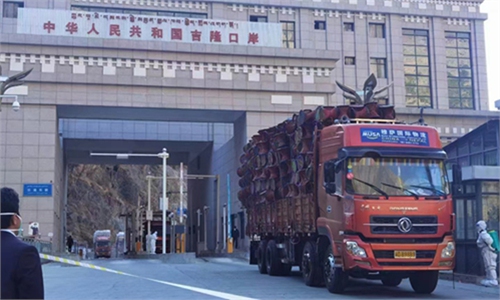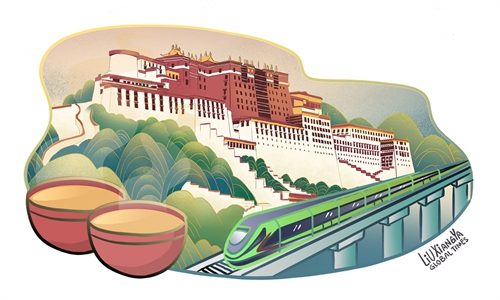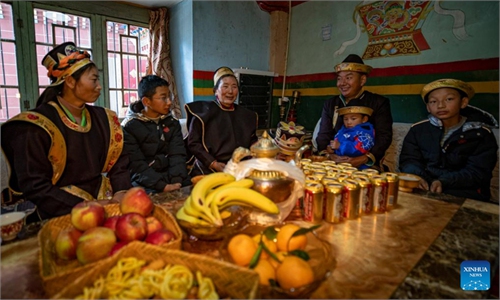IN-DEPTH / IN-DEPTH
Tibetan art a direct window for outside world to feel, understand and accept the real Xizang
Thriving charm
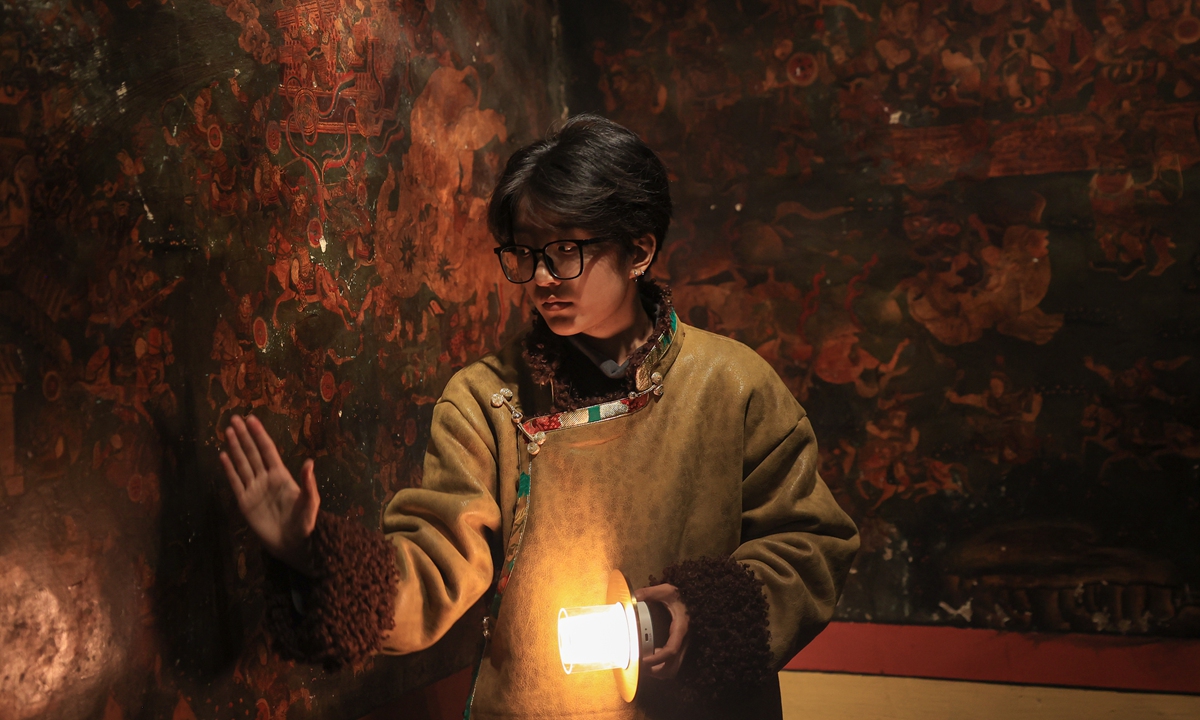
A tour guide at the Jebum-Gang Art Center shows details of the wall paintings at the center to thee visitors with light. Photo: Yang Ruoyu/GT
Hidden amid the bustling streets of Lhasa, behind famous landmarks such as the Potala Palace, Jokhang Temple, and Barkhor Street, is a cultural and artistic space that has been transformed from Xizang's first ancient architectural preservation.As the only 3D altar city ancient architectural structure in Lhasa, the Jebum-Gang Art Center embodies the essence of Tibetan architecture, art, and history. It has not only witnessed the historical ups and downs of today's Lhasa but also explores contemporary cultural expressions in the city.
Amid the current trend of revitalizing cultural heritage sites, the Jebum-Gang Art Center brings wall paintings carved on stone to life, revitalizes and has become the "energy center" of contemporary Tibetan culture, radiating the immense charm of Tibetan culture to the world. It leaves tourists in awe, giving the distinct feeling of Xizang being "very traditional, yet modern and astonishing."
Enchanting sound of bells
The melodious sound of wind chimes greets the Global Times reporters at the entrance of the Jebum-Gang Art Center through the maze-like alleys, amidst the calls of street vendors and the aroma of butter tea on Barkhor Street. Before entering the main hall, the Global Times team was informed by a docent of a special ritual: The ringing of wind chimes at the entrance to pay homage to both the ancient architecture and the ancient city.
Accompanied by the crisp sound of wind chimes, one pushes open the heavy doors, to reveal a primitive and rustic atmosphere. The structure of the circular altar city, the ancient Tibetan pillars and porches, and layers of weathered centuries-old murals slowly come into view. Here, the rare altar city architecture of ancient buildings blends with the multidimensional and serene experience, where exquisite Qing Dynasty (1644-1911) murals meet avant-garde contemporary art.
"On top of Jebum-Gang, there is a staircase that overlooks the distance. No matter which side you listen from, you can hear the enchanting sound of the bells," the docent told the Global Times. "The elderly people of the ancient city still remember this moving folk song about Jebum-Gang, which spread throughout the city and became a collective memory for several generations of Lhasa residents. Jebum-Gang's fame has also spread far and wide."
"When I was young, this place was an ancient building in the bustling market of Lhasa, serving as grain storage for the residents. I had never been inside. I vaguely heard the elderly in my family say that they used to come here as children to collect ration coupons and were told to protect the murals and carvings here," a local tourist at the center told the Global Times.
Stepping into the temple, one can see five walls that enclose three spaces: An outer corridor, an inner hall, and a central shrine. Four large doors accurately point to the four cardinal directions, starting from the south entrance. The four entrances are guarded by the goddesses of the four seasons, as well as the four heavenly guardian kings. The four entrances separate the outer corridor into four sections. Clockwise along the outer corridor, the murals on the inner side of the outer walls depict solemn Buddhist realms. These are complemented by the presence of various Buddhas and Bodhisattvas, creating a sense of the divine realm.
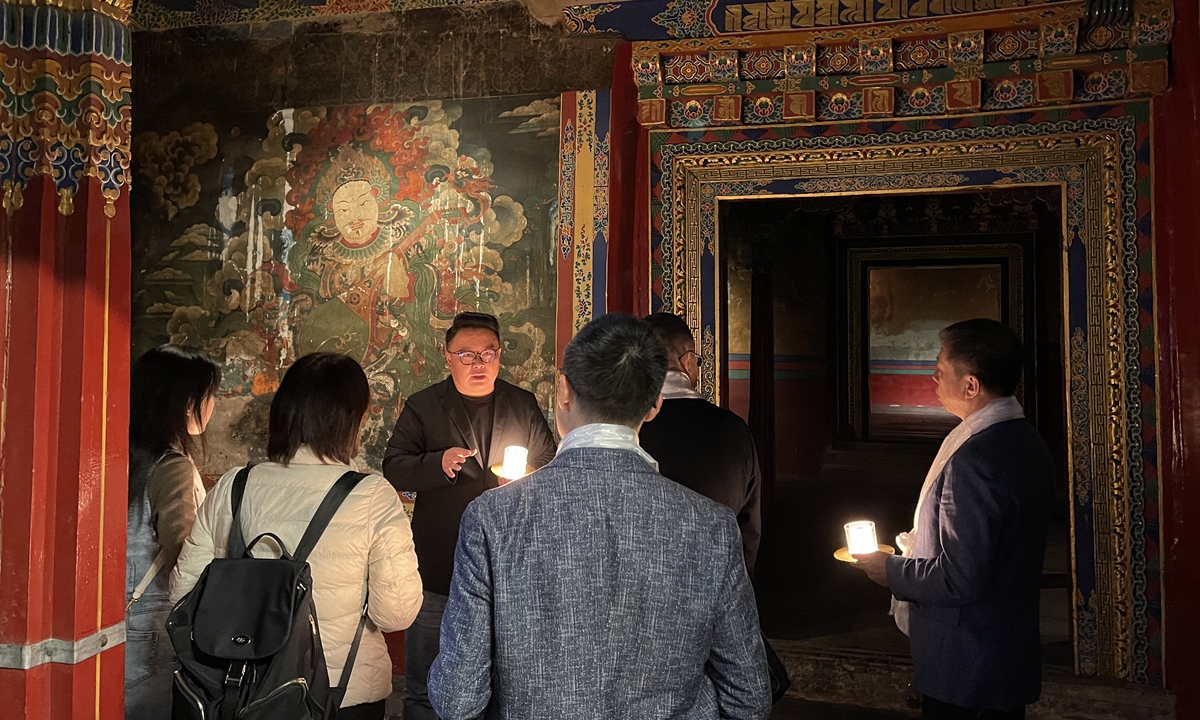
Fang Kun, founder of the Jebum-Gang Art Center, introduces wall paintings to visitors to the center. Photo: Courtesy of the Jebum-Gang Art Center
Fang Kun, founder of the Jebum-Gang Art Center and director of the China Tibet Culture Protection and Development Association, shared the history of the art center in an interview with the Global Times.
As the only remaining intact ancient building with a perfect Tibetan fortress structure in Lhasa, the "Jebum-Gang Lakang" - Lakang means "Buddhist temple" in Tibetan language - hidden in the bustling city has a legendary background. This temple, the name of which means the "holy place of 100,000 Tsongkhapa sects" in Tibetan, was originally built in the 19th century by the local Xizang government as a religious defensive structure based on the "fortress" concept in Tibetan Buddhism to resist the invasion of the British army.
However, these efforts ultimately failed to stop the invasion of the British aggressors in Lhasa in 1904. In an old photograph displayed at the art center, British invaders can be seen arrogantly walking past the Jebum-Gang Lakang, surrounded by helpless Tibetan monks and laypersons. After that, the fortress building went through various transformations and was used as Xizang's earliest substation, a grain warehouse, and a residence for the public.
The architectural structures and cultural relics with the will of the previous generations in Jebum-Gang Lakang have also faced the ravages of time and become increasingly dilapidated. In 2018, the ancient Jebum-Gang Lakang attracted great attention from the cultural and tourism department of Lhasa, and restoration work on the cultural relics began.
Regarding the future operation and maintenance of the Jebum-Gang Lakang, the local authorities hope to learn advanced experiences both domestically and internationally and seek the participation of private good faith actors in the protection and operation of the ancient building. After multiple discussions, Fang's team decided to transform the Jebum-Gang Lakang into a contemporary cultural and tourism landmark in Xizang called the "Jebum-Gang Art Center," which focuses on contemporary art exhibitions, artist residencies, art displays, and public cultural education activities.
"Previously, in our efforts to promote outstanding Tibetan culture abroad, we found that many people in the West still have a stereotypical and orientalist understanding of Xizang. When it comes to the region, many people think that Tibetans still live a primitive life or that Xizang is a sacred place isolated from the rest of the world. Some Westerners believe that Xizang should remain in its original state and do not want to see modern development in the region," Fang told the Global Times. "Yet the Tibetan people have their own traditional culture and a thriving contemporary cultural art scene, which is often overlooked."
Fang and his team's vision of transforming the Jebum-Gang Lakang into an art center was soon recognized by the cultural and tourism department of Chengguan district in Lhasa. The temple is located in the Chengguan district. After consultations and expert discussions, the cultural and tourism department officially entrusted Fang's team with the responsibility of its transformation and operation, based on the principles of reusing ancient buildings for public welfare.
"We quickly reached a consensus with architectural experts, cultural relics experts, and government departments on the principles of the transformation. We had to ensure the safety of cultural relics and murals during protection and restoration. Meanwhile, we also had to achieve the functions of a contemporary art center by installing museum-grade lighting, professional exhibition facilities, and modern exhibition technologies," said Fang.
In July 2021, the Jebum-Gang Lakang was transformed into the magnificent Jebum-Gang Art Center and reopened to the public. Since then, a series of modern art exhibitions combining Tibetan elements, as well as various cultural and educational activities for primary and secondary school students and public performances of intangible cultural heritage, have been held here.
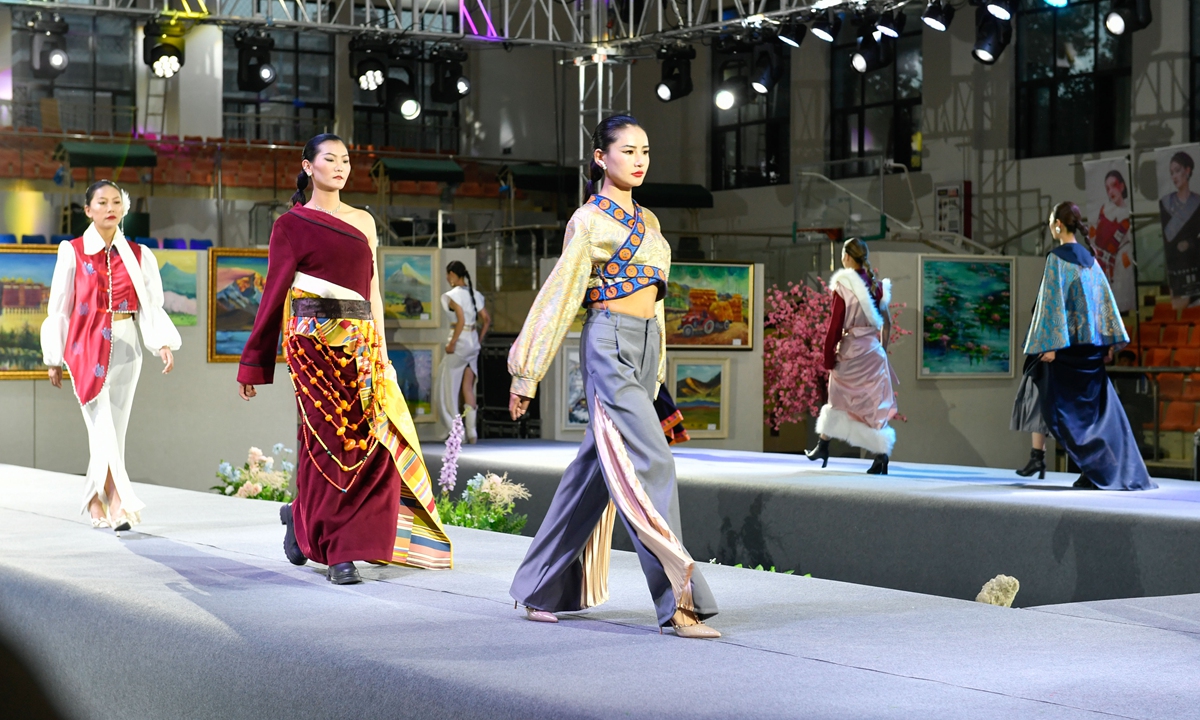
Models show clothing designed by graduates from a vocational college in Lhasa, Southwest China's Xizang Autonomous Region, at a graduation fashion show on May 26, 2023. The clothing showcases the encounter and collision between traditional Tibetan costumes and modern fashion design. Photo: VCG
Fight prejudice with truth
In recent years, people of all ethnic groups in Xizang have actively participated in the protection and development of Tibetan culture. The combination of government agencies, society, and market forces has fully mobilized the enthusiasm and creativity of the people in the cultural preservation efforts, making Tibetan cultural heritage and cultural inheritance more vibrant and sustainable. The profound historical heritage, unique artistic charm, and mysterious natural elements in the region have made it highly favored overseas.
In September 2023, during a culture week activity held at the Moscow Chinese Cultural Center, the Tibetan cultural artworks exhibited at the event were warmly received by the Russian people. A member of the Russian State Duma who attended the event said that many Russians associate Xizang with fairy tales and this event will allow Russians to touch this fairy tale and better understand Xizang, media reported.
"There are many supporters of Tibetan culture overseas, especially in the business, political, and cultural circles of Western countries," said Fang, who has been engaged in the promotion of contemporary Tibetan art for nearly 10 years.
He told the Global Times that some museums in the US and France have extended olive branches and expressed a desire to jointly hold exhibitions of contemporary Tibetan art. "These foreign museums have many precious Tibetan cultural relics, but they lack attention to contemporary Tibetan art. I realized that Tibetan art has a broad market and a 'star effect' overseas. Art can become the most direct window for foreign people to feel, understand, and accept the real Xizang."
However, Tibetan art is inevitably influenced by stereotypes and biases in the process of going global.
Fang shared a story that when his team obtained authorization from the art museum to incorporate elements of Monet's painting "Water Lilies" into the production of yak wool scarves and exported these products to Europe, Europeans were very surprised that these exquisite scarves actually came from Xizang, overturning their imagination of Xizang as "primitive and backward," which he believed was due to false and selective reporting by some biased Western media outlets.
An exhibition experience in the island of Taiwan also made Fang realize that presenting the truth is the best weapon against prejudice.
"In 2015, we organized more than 100 traditional and contemporary Tibetan art exhibits to participate in an exhibition in the island of Taiwan, which included ancient sculptures, murals, thangkas, as well as modern oil paintings and performance art. At that time, some Taiwan residents believed that Tibetan culture had suffered serious destruction. For those who were so woefully misinformed, our approach was to extend invitations to facilitate explanations and visits," noted Fang.
During the Taiwan trip, the staff provided detailed explanations of the cultural connotations of each exhibit and the creative process of Tibetan artists, patiently dispelling the doubts in the minds of those in attendance. In frank communication, Taiwan visitors were impressed by the wisdom of the ancient people, the craftsmanship of folk artisans, and the creativity of modern artists, realizing that traditional Tibetan culture is brilliant and excellent, and modern Tibetan culture has been fully transmitted through the generations. Their understanding of Xizang was thus refreshed, he continued.
"I told a politician in the island that the protection of culture is a dynamic process, and if any ethnic culture can only exist in museums, it will accelerate its demise," Fang said. "In Xizang, excellent traditional culture has been inherited and developed, integrated into the lives of the Tibetan people, and young artists and cultural practitioners are thriving and diverse. As long as people can come into contact with the real Xizang, many rumors and prejudices will be debunked."
At the press conference for the release of the CPC Policies on the Governance of Xizang in the New Era: Approach and Achievements white paper, held on Friday, Yan Jinhai, deputy secretary of the CPC Xizang Autonomous Regional Committee and chairman of the people's government of the Xizang Autonomous Region, stated that many foreign politicians, diplomats, and journalists have visited Tibetan villages and seen the real lives of the people and their overwhelming sense of happiness. All of this is completely different from the propaganda they hear abroad.
"We sincerely invite friends from all walks of life to come to Xizang in person, experience the beauty of the natural scenery, ethnic customs, unity and harmony, and pioneering spirit, and objectively and truthfully introduce the socialist new Xizang to the world," Yan said.


